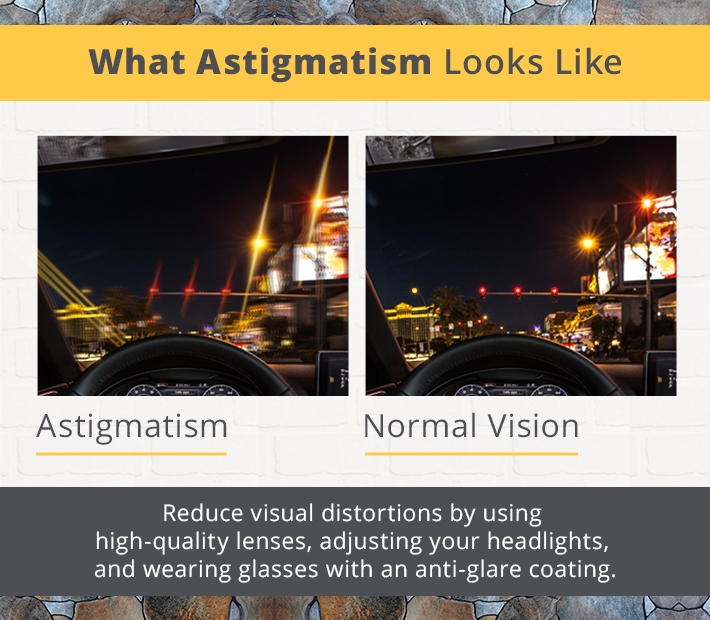Nighttime driving can be difficult at the best of times, but with high levels of astigmatism, it can become downright dangerous.
Astigmatism can distort how lights look at night, creating haloes and blurriness around headlights, traffic lights, and other things a person needs to navigate the roads safely. If you’re not sure if you have astigmatism, the first step is to get in touch with your eye doctor and schedule an eye exam.
If it turns out you have astigmatism, there are several steps you can take to make driving at night safer and more comfortable:
- Use high-quality lenses
- Clean your lenses frequently
- Adjust your headlights
- Take breaks if necessary
- Reduce glare
What Is Astigmatism?
Astigmatism occurs when the shape of your eye is slightly irregular. Instead of having a perfectly round cornea (the clear front surface of the eye), individuals with astigmatism have a cornea that is shaped more like a football. This irregular curvature causes light to focus unevenly on the retina, leading to blurred or distorted vision at various distances.
If you’re experiencing any of the following symptoms, there’s a chance you might have this condition:
- Blurry vision, both near and far
- Difficulty seeing fine details
- Eye strain or fatigue
- Squinting to see clearly
The simplest and most common solution for astigmatism is wearing prescription eyeglasses. They help compensate for the irregular cornea shape, allowing light to focus on the retina properly. Astigmatism can also be corrected with contact lenses or refractive surgery.

Why Does Astigmatism Affect Night Driving?
Many people with astigmatism find that their visual challenges become more pronounced when driving in low-light conditions.
When the sun sets and darkness descends, our pupils naturally dilate to allow more light to enter the eyes. This increase in pupil size amplifies any existing vision issues, including astigmatism. The irregular shape of the cornea causes light to scatter instead of focusing precisely on the retina, leading to blurred or distorted images.
What People with Astigmatism See
Imagine driving down a dimly lit road with oncoming headlights. For those without astigmatism, the light from the headlights appears as a single, defined beam. But for individuals with astigmatism, the irregular curvature of the cornea can cause the light to spread out, creating halos or streaks around the lights. It’s like looking through a slightly unfocused lens, which can make it challenging to see clearly.
Not only that, but astigmatism can also affect your ability to perceive depth and judge distances accurately, especially in low-light situations. This can make it harder to spot obstacles, read road signs, or react to sudden changes on the road. If you notice astigmatism affecting your vision in this way, there are a few things you can do to see more clearly.
- Use High-Quality Lenses
The first step to safe and comfortable night driving with astigmatism is to make sure you have high-quality lenses. Poor-quality lenses can distort your vision, making it harder to see clearly at night. Invest in high-quality contact lenses or glasses that correct your astigmatism and help you see more clearly in low-light conditions. Ask an eye care professional for advice on the best lenses to suit your needs.
- Clean Your Lenses Frequently
Dirty lenses can worsen your vision and make it harder to see clearly at night. Make sure to clean your lenses frequently, using a solution that is safe for your particular lenses. Keep a bottle of cleaning solution and a microfibre cloth in your car so you can clean your lenses anytime you need to.
- Adjust Your Headlights
Properly adjusted headlights can make a big difference in your night driving experience. Aim your headlights slightly lower than usual to avoid blinding other drivers, but make sure they still provide enough light to see the road ahead. If you’re not sure how to adjust your headlights, consult your car’s owner’s manual or take your car to a mechanic for assistance.
- Take Breaks if Necessary
If you start to feel tired or your vision becomes blurry, pull over and take a break. Driving while fatigued or with blurry vision can be dangerous, especially at night. Take a few minutes to rest and allow your eyes to adjust to the darkness before getting back on the road.
- Reduce Glare
Glare from other cars or streetlights can be a major problem for people with astigmatism. To reduce glare, use an anti-glare coating on your lenses or consider wearing a visor. You can also adjust your rearview mirror to reduce the amount of glare from cars behind you.
Learn More About Driving Safely with Astigmatism
If astigmatism is affecting your vision at night, it may take some trial and error to find what works for you. No matter what’s affecting your vision, your eye doctor can be a great resource in helping you see more clearly and comfortably in low-light situations. Visit us at Calgary Optometry Centre for advice on lens types, coatings, and lifestyle adjustments that can help you navigate the roads more safely. We can also assess your eye health and determine if there’s anything else affecting your vision. Contact us to book an appointment today.




